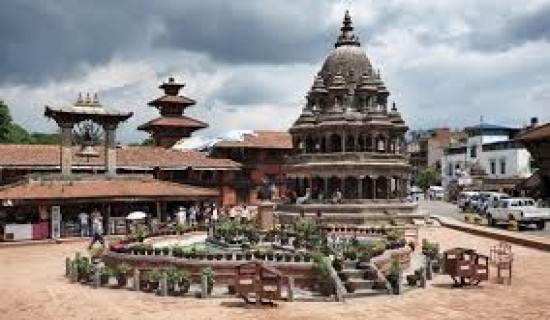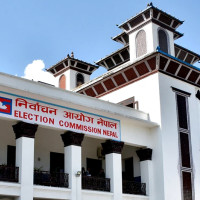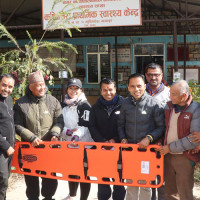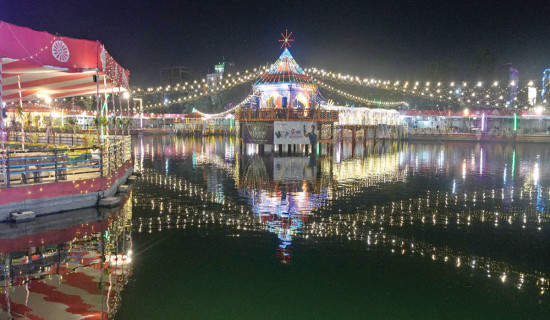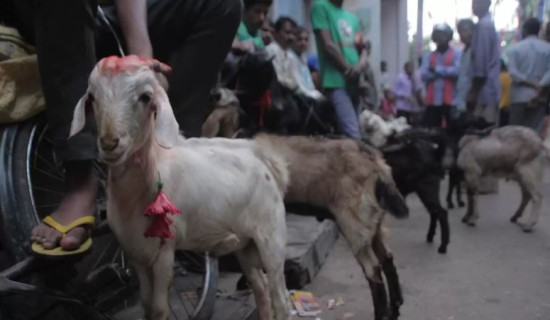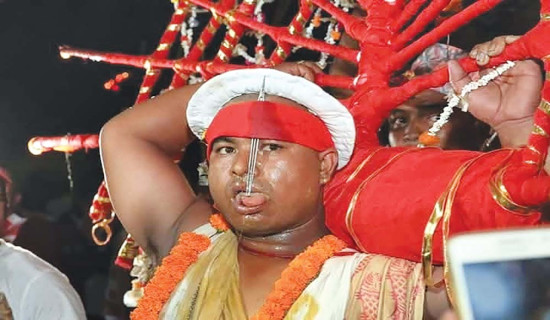- Saturday, 3 January 2026
Restoration of Lichchhavi era Yanga Hiti underway
Kathmandu, July 6: Traditional Hitis (stone spouts) which were concealed under bushes, shrubs, and water are now being restored to their former glory thanks to the Bagmati Province government and Yanga Hiti Renovation Programme Consumer Committee.
Advocating the need for the preservation of historically significant structures for the last couple of years, locals have finally succeeded in beginning restoration work of the neglected Hitis of their areas.
The Lichchhavi era Yanga Hiti, located at the Yangal of Ward No. 23 of Kathmandu needed preservation.
However, the historically significant structure of the Metropolis had been neglected by concerned authorities for a long time.
Now, the restoration and excavation processes of the abandoned Hiti are underway.
Historical and unique examples of Lichchhavi period architecture, a place of religious merit featuring stone sculptures, idols of Buddha, Vishnu, Bhagirath and an ancient Shivlinga, which were concealed under the bushes and water, are now being restored to their former glory after the Bagmati Provincial government allocated budget for the work.
With the joint budget of the Bagmati Provincial government and the Yanga Hiti Renovation Programme Consumer Committee, the Hiti is now under the restoration and excavation process.
The restoration and excavation works are carried out with the financial assistance of Rs. 6.7 million from the Ministry of Culture, Tourism and Cooperatives of Bagmati Province and Rs. 781,252 from the Consumer Committee.
The estimated restoration cost is about Rs. 7.5 million.
The restoration and excavation works on the stone spout began on April 23, 2024, after signing an agreement on April 13, 2024, with Yanga: Hiti Restoration Programme Consumer Committee.
The Department of Archeology is monitoring the restoration and excavation works.
During the excavation, a pre-medieval brick structure was found in the Yanga: Hiti complex. A pile of embers and ashes has also been found inside a brick structure.
It is assumed that the discovered structure could be a place for mourners after someone's death, said Uddhav Acharya, an archaeologist.
Acharya said that an archaeologically important structure had been found during the excavation, adding that the brick structure found here could be a living room during the mourning period. The discovered wall structure, road and steps are more than 100 years old, he added.
After clearing the stored water and bushes, three inscriptions of about 1,400 years old and two Lichchhavi-era inscriptions of about 1382 years old appeared in the complex.
Of the three spouts recovered, the main Hiti of the centre is of the Malla era and the two which are on either side of the main are of Lichchhavi time, said Manjari Pradhan, an archaeologist at the DoA.
The stone inscription dated ‘Samvat 64’ mentions the coronation of Bhimarjunadeva and Bishnu Gupta in Mangriha (a palace), another inscription dated ‘Samvat 67’ mentions the coronation of King Narendradeva and the non-dated third inscription of Bhimarjunadeva and Bishnu Gupta are keep at the Hiti complex, she said.
Sujan Bajracharya, Chairperson of the Consumer Committee, said that among the three Hitis, water tickles from only one spout. The old traditional water canals that used to supply water at the spouts were also found.
During the working process, water sources of canals have been found, Water is coming from the canals of the north and southeast part, he said.
Ground-penetration radar (GPR) was used twice at the Hiti complex with the technical support of Chiva Chaitya Organisation and the water canal of the eastern side was found after using it, he added.
In the leadership of water heritage experts, Padam Sundar Joshi, the supply system of Hiti complex is being studied, he said.
Also in 2007, the Hiti was restored by a local Consumer Committee but at that time, concrete materials were used against the archaeological norms. These concrete structures have now been demolished and removed from the site and the spouts will be restored using traditional materials, he said.
“Since my childhood, I have seen that the neglected Hiti was buried under bushes and a garbage disposal site,” said Durga Man Dangol, 86, a resident of Yangal tole.
Earlier, the Hiti was surrounded by a wall, so nobody could notice the historical heritage, he said.
Dangol said, “I feel disheartened to see such historical structures getting destroyed and forgotten. Thankfully, the Consumer Committee was formed and it took initiative to restore the neglected Hiti.”



